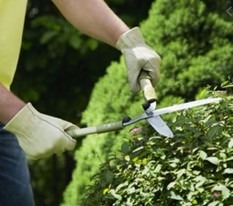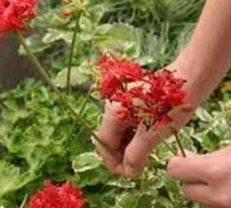What Gardening to Do in June? Water, Sow and Prune!
Keep Plants Watered, Sow Starters for Late Summer and Fall Veggies, and Prune Flowering Plants.
It’s feeling like Summer … to plants as well as people. In the middle of June, let’s take a look at gardening priorities, including a helpful 11-minute video from Walnut Ridge Owner, David Julius. Click on the image for the video, or just take a look at the summary points below. And we’ve added some timely tips to help keep your current and future blooms beautiful, and to help choose ideal veggies for late Summer and Fall!
June Gardening Tips from Walnut Ridge
- Prune Flowering Shrubs in June … by July 1 at the Latest.
If you haven’t already, be sure to trim your flowering shrubs – Forsythias, Azaleas, Rhododendrons, etc. – after they have bloomed. Trim them by July 1, and don’t trim any later, or you’ll be cutting off next year’s blooms.

- Prune Other Shrubs in Summer … by September 1.
Other shrubs – evergreens, boxwoods, etc. – should be pruned by Sept. 1. Pruning stimulates growth, and you don’t want to stimulate late, vulnerable growth that could then be killed by Winter’s frosts.
- Be Sure Plants and Trees Are Getting Water, Especially (and More) if They’re New
If we’re getting rain every week or every two weeks, plants and trees of three years old or older should be fine. Newer plants need water … about an inch per week. A trickle hose on new plants and trees for about 20 minutes per week should be fine for ensuring an inch per week. In severe dry heat, water the older plants as well. Don’t overwater! Over-watering will drown and kill the roots, especially those of freshly planted trees, shrubs, plants.
- Stay on Top of Pulling or Killing Weeds, and Prevent Them with Mulch
Weeds steal water from plants. Keep pulling the weeds, or shoot them with Roundup as soon as you see them poking through the soil. (Don’t let the weeds grow too high, or you risk hitting other plants with Roundup when you spray them.) Keeping a couple of inches of mulch on flower beds will help to keep the weeds from growing. Mulch also helps hold moisture for your plants.
- Keep Fertilizing Annuals and Newer Shrubs with Water Soluble Fertilizer
Flowering plants and shrubs best absorb the nutrients of fertilizers by their roots through the water-soluble products, meaning the types of fertilizers you mix with water and then pour or spray onto and around the plants. Miracle Grow and Monty’s Joy Juice are two popular brands, but there are many. Continue fertilizing about every two weeks through the summer. - Keep an Eye on Insect Activity
Red spider mites and bagworms are the main insects that could cause damage and disease to plants and trees. If you see them or signs of disease and dying of limbs in trees, call your arborist or Walnut Ridge at 812-288-6691 to discuss the severity of the infestation and possible treatments. - For the Most Color and Blooms Through Summer, Keep Dead-Heading the Recurring Blooms
On flowering plants that continuously bloom (rather than just blooming once), such as Geraniums, Rhododendrons, Roses and Daylilies, keep dead-heading the blooms after they have wilted, and you will enjoy more color and blooms.
- Give the Lawn Some Love ... and Plenty of Water
Basically … the water for a green lawn has to come from somewhere. If it’s not coming from the clouds, it will need to be from the hose. To keep the lawn from going yellow, if it’s not raining, give a regular sprinkle. And as the temperatures rise, set the blades a little higher to keep the grass just a little longer, to keep the grass from getting burnt down at soil level.
More Tips for Warm-Season Planting

- Get in the Zone … 6
When it comes to just about any plants, including vegetables, we (in the Kentuckiana area) should mostly follow Zone 6 planting instructions. This Zone runs moderate/temperate with extreme lows only getting down to about -10F, stretching from New England in the East down through Ohio and Kentucky, over to northern parts of New Mexico and Arizona, then up to southern parts of Washington State. Regarding what and when to plant in Zone 6, you can consult Google for some reputable gardening sites and almanacs, or call us at Walnut Ridge, or look for Zone 6 planting instructions on packages of seeds or directions of plants. Be sure to follow sun, shade and water directions, too! - Sow the Starters ("Cheaters"), and Keep Sowing for Waves of Blooms, Herbs and VeggiesDirect sow sunflowers, marigolds, basil, and other warm-season flowers and herbs. Do the same with warm-season vegetables, continuing to use "cheater"-starters for the warm season vegetable crops such as beans, summer squash, and cucumbers. About a week apart, plant more to keep the blooms, herbs, and veggies coming in waves.

- Vegetables Need Plenty to Drink, but Not Too Much
Water your vegetable garden thoroughly once a week instead of light watering every day. You’ll develop a deeper root system that will help the plants survive the dryer weather into the late Summer. - More Mulch!
Adding mulch will help with weed control and keep the garden soil moist. About once a month, freshen up mulch around woody plants, perennials and vegetables.
Most importantly, keep enjoying the fruits of your labor! ... whether it is actual fruit, vegetables or beautiful blooms of your perennials and annuals. Don't hesitate to give us a call at Walnut Ridge, (812)288-6691, to help you decide what to plant, and how.

